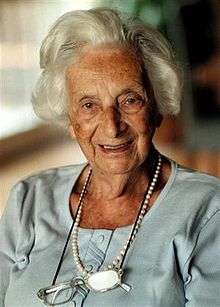Eugenia Sacerdote de Lustig
Eugenia Sacerdote de Lustig (9 November 1910 – 27 November 2011)[1] was an Italian-born Argentine physician. She was the first to test the polio vaccine in Argentina. She published more than 180 works.
Eugenia Sacerdote de Lustig | |
|---|---|
 | |
| Born | Eugenia Sacerdote 9 November 1910 Turin, Italy |
| Died | 27 November 2011 (aged 101) Buenos Aires, Argentina |
| Occupation | Physician |
| Awards | Rebeca Gerschman Award (2010) |
Early life and education
Eugenia Sacerdote de Lustig was born in Turin on 9 November 1910.
In 1929, Sacerdote de Lustig decided to study medicine in Italy, at a time when women were not choosing this career. Together with her first cousin Rita Levi-Montalcini,[2] she was one of the first four women who were not able to forget their gender as they were taught with 500 men.[3]
Career
Her career was difficult; even so, she was selected as assistant professor of histology at University of Turin by professor Giuseppe Levi.[2] With the rise of fascism, she lost her job because she was Jewish. Her husband's employers arranged for them to emigrate, with their daughter, to Argentina in 1939. In Argentina her qualifications allowed her to research but not to teach.[3] She became the chair of histology at the University of Buenos Aires. She cultivated living cells in vitro, a technique that allows the study of different types of viruses and tumors.[2]
When the epidemic of poliomyelitis occurred, Sacerdote de Lustig was sent by the World Health Organization to the United States to learn about the work of the professor Jonas Salk. When she returned to Argentina, she inoculated herself in public and did the same with her children to convince the population of the benefits of the polio vaccine.[2]
Since 1989, she investigated the role of free radicals and oxidative stress in living patients with Alzheimer's disease, vascular dementia and Parkinson's disease, expanding the basic knowledge of neurological diseases.
Sacerdote de Lustig was a researcher at CONICET and head of virology at Instituto Malbrán. For more than 40 years, she studied tumor cells in the Instituto de Oncología Ángel H. Roffo. She continued to work in the laboratory into her eighties, ceasing to do so when blindness prevented her from accurately working with a microscope.[2]
She received the 2010 Rebeca Gerschman Award for outstanding research work.[4]
There are more than 180 of her scientific publications in the records of the Institute of Oncology Ángel H. Roffo, the Instituto Malbrán and CONICET.[2]
References
- "A los 101 años, murió la doctora Sacerdote de Lustig". Diario La Nación. Retrieved 29 November 2011.
- "A los 101 años, murió la doctora Sacerdote de Lustig" La Nación, 29 November 2011.
- Sandra McGee Deutsch (22 June 2010). Crossing Borders, Claiming a Nation: A History of Argentine Jewish Women, 1880–1955. Duke University Press. pp. 85–. ISBN 0-8223-9260-7.
- "Se conocieron los ganadores de los premios Houssay y Rebeca Gerschman 2010" [Winners of the 2010 Houssay and Rebeca Gerschman Awards Revealed] (in Spanish). UnLaM Agencia CTyS. 12 March 2011. Retrieved 23 April 2020.